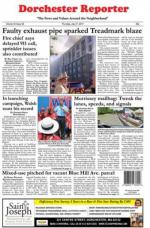December 30, 2010
Norfolk Street is a busy thoroughfare that winds its way from Blue Hill Avenue in Mattapan to Codman Square. As the neighborhoods it traverses have changed to dramatic effect over the last century, numerous churches of diverse congregations have sprung up along the route, their houses of worship often offering a stark contrast to the stately edifices of mainstream congregations like Second Church in Codman Square, religious home of Protestant worshippers going back to the early 19th century, and Stanton Street’s St. Matthew’s Church.
During the fall, the Reporter engaged with a team of journalism students from Northeastern University to set out and take the measure of church life along Norfolk Street in 2010. Their report follows:
Tying churches to their community
By David Gass and Young Kim
St. Angela’s Roman Catholic Church sits at the corner of 1540 Blue Hill Avenue and Fremont Street, the southwestern anchor to the string of religious houses that runs along Babson Street and onto church-rich Norfolk Street.
St. Angela’s is host to a trilingual congregation; On Sundays, two priests run the morning service, one in French and one in English. In the afternoon, there is an English Mass led by Rev. William Joy. In the late afternoon, a third Mass is said in Creole.
Joy is the senior pastor of St. Angela’s who also heads up St. Matthew’s Parish up the road toward Codman Square. On any given Sunday, about 1,200 congregants attend the three Masses, a large number of them Haitians with a small number of Vietnamese.
The history of St. Angela’s has been marked by dramatic change in the neighborhood. During the middle years of the last century, nearby Mattapan Square was the legendary heart of Boston’s Jewish community. By the late 1960s and early 1970s, the Jewish community had decamped and been replaced by diverse ethnic constituencies. For all that, says Father Joy, “People have always wanted to be involved with their local church in the community.”
St. Angela’s connections involve local meetings with the Jubilee Christian Church at 1500 Blue Hill Ave. and the Church of Holy Spirits located at 525 River St. In a recent collegial enterprise, the three churches worked together to apply to the federal government for financing a Main Streets program, an initiative that works at enhancing a neighborhood’s business prospects. They also collaborate often on volunteer programs, such as humanitarian relief in Haiti after the January earthquake and volunteer work with local hospitals.
A short hitch up Fremont and a left on Babson Street takes a traveler to La Nouvelle Eglise de Dieu de la Pentecôte, a Pentecostal church primarily serving Haitian immigrants. The church holds its main worship at 11 on Sunday mornings in Creole. The service is led by the Revs. Elenor Lavalas and Jean Prime.
Four blocks away, at 573 Norfolk St., the Gladtidings House of Prayer for All Nations serves a congregation hailing mostly from the West Indies and the Carribean. Founded in 1979 in the living room of the current pastor’s home in Hyde Park, the church moved to multiple locations before finally settling in its current location at the corner of Wilmore Street in 1996.
The building, marked by a distinctly modern appearance, and substantial crosses in front and behind, seats about 450 and the church holds its main worship services in the morning and evening every Sunday, led by Bishop Hezron Farrell and his wife, the Rev. Gwendolyn Farrell. The Gladtidings church follows the Pentecostal faith, but considers itself independent and under no larger umbrella organization.



